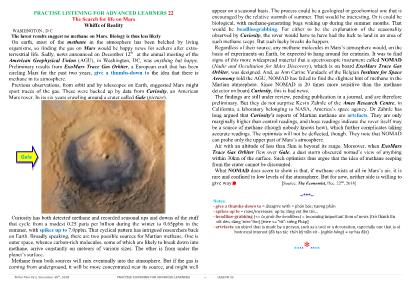Bài thực hành nghe Tiếng Anh nâng cao - Bài 22 - Thẩm Tâm Vy - Năm 2018 (Có âm thanh)
Bạn đang xem tài liệu "Bài thực hành nghe Tiếng Anh nâng cao - Bài 22 - Thẩm Tâm Vy - Năm 2018 (Có âm thanh)", để tải tài liệu gốc về máy bạn click vào nút DOWNLOAD ở trên

Thẩm Tâm Vy’s, December 25th, 2018 PRACTISE LISTENING FOR ADVANCED LEARNERS – LESSON 22 PRACTISE LISTENING FOR ADVANCED LEARNERS 22 The Search for life on Mars Whiffs of Reality WASHINGTON , D C The latest results suggest no methane on Mars. Biology is thus less likely On earth, most of the methane in the atmosphere has been belched by living organisms, so finding the gas on Mars would be happy news for seekers after extra- terrestrial life. Sadly, news announced on December 12 th at the annual meeting of the American Geophysical Union (AGU), in Washington, DC, was anything but happy. Preliminary results from ExoMars Trace Gas Orbiter, a European craft that has been circling Mars for the past two years, give a thumbs-down to the idea that there is methane in its atmosphere. Previous observations, from orbit and by telescopes on Earth, suggested Mars might sport traces of the gas. These were backed up by data from Curiosity, an American Mars rover. In its six years crawling around a crater called Gale (picture). Curiosity has both detected methane and recorded seasonal ups and downs of the stuff that cycle from a modest 0.25 parts per billion during the winter to 0.65ppbn in the summer, with spikes up to 7.0ppbn. That cyclical pattern has intrigued researchers back on Earth. Broadly speaking, there are two possible sources for Martian methane. One is outer space, whence carbon-rich molecules, some of which are likely to break down into methane, arrive constantly on meteors of various sizes. The other is from under the planet’s surface. Methane from both sources will mix eventually into the atmosphere. But if the gas is coming from underground, it will be more concentrated near its source, and might well appear on a seasonal basis. The process could be a geological or geochemical one that is encouraged by the relative warmth of summer. That would be interesting. Or it could be biological, with methane-generating bugs waking up during the summer months. That would be headlinegrabbing. For either to be the explanation of the seasonality observed by Curiosity, the rover would have to have had the luck to land in an area of such methane seeps. But such lucky breaks do happen. Regardless of their source, any methane molecules in Mars’s atmosphere would, on the basis of experiments on Earth, be expected to hang around for centuries. It was to find signs of this more widespread material that a spectroscopic instrument called NOMAD (Nadir and Occultation for MArs Discovery), which is on board ExoMars Trace Gas Orbiter, was designed. And, as Ann Carine Vandaele of the Belgian Institute for Space Aeronomy told the AGU, NOMAD has failed to find the slightest hint of methane in the Martian atmosphere. Since NOMAD is 20 times more sensitive than the methane detector on board Curiosity, this is bad news. The findings are still under review, pending publication in a journal, and are therefore preliminary. But they do not surprise Kevin Zahnle of the Ames Research Centre, in California, a laboratory belonging to NASA, America’s space agency. Dr Zahnle has long argued that Curiosity’s reports of Martian methane are artefacts. They are only marginally higher than control readings, and those readings indicate the rover itself may be a source of methane (though nobody knows how), which further complicates taking accurate readings. The optimists will not be deflected, though. They note that NOMAD can probe only the upper part of Mars’s atmosphere. Air with an altitude of less than 5km is beyond its range. Moreover, when ExoMars Trace Gas Orbiter flew over Gale, a dust storm obscured nomad’s view of anything within 30km of the surface. Such optimists thus argue that the idea of methane seeping from the crater cannot be discounted. What NOMAD does seem to show is that, if methane exists at all in Mars’s air, it is rare and confined to low levels of the atmosphere. But for now, neither side is willing to give way. [Source: The Economist, Dec. 22nd, 2018] ~***~ Notes. - give a thumbs-down to = disagrre with = phản bác; tương phản - spikes up to = rises/increases up to: tăng vọt lên tới - headline-grabbing (<= to grab the headlines) = becoming important item of news (trở thành tin sốt dẻo, đăng ‘titre’ lớn) [titre <= “tít”: tiếng Pháp] - artefacts: an object that is made by a person, such as a tool or a decoration, especially one that is of historical interest (đồ tạo tác thời kỳ tiền sử - (nghĩa bóng) = sự bịa đặt) **>** Gale
Tài liệu đính kèm:
 bai_thuc_hanh_nghe_tieng_anh_nang_cao_bai_22_tham_tam_vy_nam.pdf
bai_thuc_hanh_nghe_tieng_anh_nang_cao_bai_22_tham_tam_vy_nam.pdf The Serach For Life On Mars.mp3
The Serach For Life On Mars.mp3





